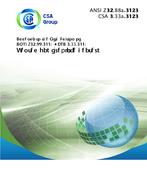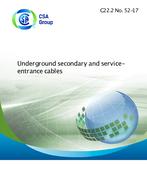Preface
This is the first edition of CSA NGV 4.3, Temperature compensation guideline for compressed natural gas vehicle fueling.
Scope
1.1 This Standard details the performance requirements for temperature compensation control used to prevent compressed natural gas (CNG) dispensing systems from exceeding a safe fill level of vehicle fuel storage container(s). This Standard contains safety performance guidelines for compressed natural gas fueling dispenser temperature compensation systems. It applies to field evaluation of existing dispensing systems designed primarily to allow for full fill and to avoid over-pressurization of vehicle fuel storage containers under operating temperature conditions as specified in this Standard. This Standard applies to CNG fueling of vehicle containers with service pressures of P30 [20 700 kPa (3,000 psi)], P30HD [20 700 kPa (3,000 psi)], P36 [24 800 kPa (3,600 psi)], and P36HD [24 800 kPa (3,600 psi)]. P30HD and P36HD are designations used in accordance with CSA/ANSI NGV 1, and throughout the document the use of P30 and P36 are also applicable to P30HD and P36HD, respectively (see Annex A regarding applicable vehicle service pressures). This guidance does not apply to onboard vehicle temperature compensation systems or components. This Standard is applicable to the dispensing of only natural gas that meets quality and interchangeability specifications contained in U.S. Federal Energy Regulatory Commission (FERC)- approved gas tariffs. 1.2 All dimensions used in this Standard are in metric units [International System of Units (SI)], unless otherwise specified. If a value for a measurement, as given in this Standard, is followed by an equivalent value in other units, the first stated is to be regarded as the specification. If a value for a measurement and a corresponding value in other units are both specified as a quoted marking requirement, either the first stated unit, or both, are to be provided. 1.3 All references to pressure throughout this document are to be considered gauge pressures unless otherwise specified. 1.4 The requirements of this Standard are not intended to constrain innovation. When considering fuel compositions, controls, materials, designs, or constructions not specifically dealt with in this Standard, these alternatives are to be evaluated as to their ability to yield levels of safety and performance equivalent to or better than those prescribed by this Standard. 1.5 In the case of conflict between this Standard and Federal, Provincial, State, or Local requirements, the governmental requirements take precedence. 1.6 In this Standard, “shall” is used to express a requirement, i.e., a provision that the user is obliged to satisfy in order to comply with the standard; “should” is used to express a recommendation or that which is advised but not required; and “may” is used to express an option or that which is permissible within the limits of the Standard. Notes accompanying clauses do not include requirements or alternative requirements; the purpose of a note accompanying a clause is to separate from the text explanatory or informative material. Notes to tables and figures are considered part of the table or figure and may be written as requirements. Annexes are designated normative (mandatory) or informative (non-mandatory) to define their application.
Product Details
- Edition:
- 1st
- Published:
- 01/01/2018
- ISBN(s):
- 9781488309083
- Number of Pages:
- 35
- File Size:
- 1 file , 1.4 MB
- Product Code(s):
- 2425465, 2425465, 2425465


